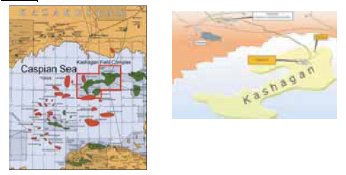Originally appeared in OTC .07 Show Daily newsletter, May 2, 2007.
Led by the likes of Kashagan and Tengiz, Kazakhstan is ramping up to develop hydrocarbon resources believed to exceed 30 billion barrels of oil and 70tcf of gas.
Bracewell & Giuliani’s Greg Vojack who has lived in the country since 1994, examines the recent history and future prospects of the Caspian’s Kazakh sector. The world’s largest oil discovery in the past decade was made on the turn of the millennium in the northern portion of the Caspian Sea, in shallow offshore waters: Kashagan, where original oil-in-place is reported to stand at 38 billion barrels. Reserves, based on pressure maintenance through gas injection, are estimated to be 13 billion barrels of light crude oil of 42-45°API. The field covers an area of 47 miles by 22 miles located about 50 miles south of the Kazakhstan city of Atyrau.
Energy is Kazakhstan’s leading economic sector. In 2003, the country produced 360 million barrels of crude oil and natural gas condensate, of which more than 86% was exported. Natural gas production in the same year was 490bcf. The country’s oil reserves exceed 30 billion barrels and natural gas reserves exceed 70tcf. Compared to the US, Kazakhstan has 1.5 times as much oil and over three times the natural gas.
The Kashagan field is operated by Eni with a 18.52% interest and partnered by ExxonMobil (18.52%), Shell (18.52%), Total (18.52%), ConocoPhillips (9.26%), KasMunaiGaz (KMG) (8.33%) and Japan’s Inpex Holdings (8.33%). Due to the technical difficulties in extracting sour crude oil in a harsh climate, initial production is unlikely before 2010. This will trigger penalties paid to the government of $250 million at a rate of $50 million/yr from 2005 – the original planned start-up date.
Investors were originally over optimistic regarding Kashagan, and the delays come as no surprise to people familiar with the climate and situation. Kazakhstan must grow slowly, and every infrastructural development helps not only the country itself, but foreign chances for oil extraction.
The Kashagan development project is a unique combination of complex geology, technical problems, and environmental challenges. It is also one of the largest upstream projects in the world today. Harsh climate in this part of Kazakhstan has temperatures varying from –40°F in winter to +104°F in the summer.
The sea waters are frozen for five months with thicknesses of up to 2ft. Sea level can fluctuate (principally due to wind tides) from 0-12ft. To combat these problems, Eni has begun using artificial islands for drilling locations rather than Sunkar, the Parker-owned drilling rig which was used for the early exploration wells, which are up to 16,000ft deep. According to the Middle East Economic Survey, the drilling of each well in the North Caspian PSA costs over $100 million, making these ‘among the most expensive in the industry’. The sour crude contains 16-20% H2S which must be removed and re-injected at high pressures, up to 12,000psi. Eni has awarded a contract to GE to supply the required ultra-highpressure sour gas injection system. Eventually, a $4 billion processing plant will be built to recover elemental sulfur from this gas. Project investment will exceed $19 billion by 2011 and will exceed $30 billion by the time the plateau production rate of 1.5 million b/d of oil is reached by 2019.
Fortunately, Eni is assisted by a consortium of the largest majors in the world, with access to capital and vast experience in challenging projects. However, few projects even approach Kashagan in its need for innovative, cutting-edge technologies. Additionally, several partners have dropped out of the production sharing agreement area formed in 1997. KMG and Inpex came into the PSA and other partners have used rights of pre-emption to increase their interests. These changes have caused delays in project approval, which finally occurred in February 2004.
So far, only the reserves of Kashagan field have been determined. The adjacent reserves of three other fields – namely Aktote, Kairan, and Kalamkas in the same PSA area -- have yet to be adequately explored.
If Tengiz is any example, then the prospects in Kashagan are exceedingly favorable. The Tengiz oil field in western Kazakhstan anchors a new pipeline built by the Caspian Pipeline Consortium (CPC) which extends to the Russian Black Sea port of Novorossiysk. The pipeline began operating in 2001. Tengiz, discovered in 1979, contains 25 billion barrels of oil originally in place, of which recoverable reserves are estimated at 6-9 billion barrels.
This makes Tengiz the sixth largest oil field in the world. The crude oil contains 16% hydrogen sulfide which is being removed, converted to sulfur, and stored on site in a huge and growing mountain. The TengizChevrOil (TCO) joint venture has developed the field since 1993. The major partners in TCO are Chevron (50%), ExxonMobil (25%), KazMunayGas (20%), and Russian LukArco (5%).
Approximately one third of Kazakhstan’s daily oil production comes from Tengiz’s 450,000b/d output. TCO has indicated that production could reach 700,000 bopd by 2010. The Baku-Tbilisi-Ceyhan pipeline is a competing pipeline put forth by US interests to bypass dependence on the Russian pipeline. In addition, Total is interested in developing a pipeline south from Kashagan and near Tengiz to extend through Iran -- the lowest-cost route. Due to the geopolitical climate surrounding Iran, however, this route is not favored by the US.

The North Caspian Sea region already represents a hydrocarbon resource of some 30 billion barrels of oil and 70tcf of gas. To support drilling operations at Kashagan, Agip KCO has constructed two artificial drilling islands, A and D (shown above). Island D will be at the centre of what is going to become Hub 1, a complex structure made of islands and ice protection barriers that will house offshore production facilities for the first phase of the Kashagan megaproject.
The content of this article is intended to provide a general guide to the subject matter. Specialist advice should be sought about your specific circumstances.
